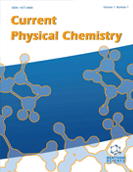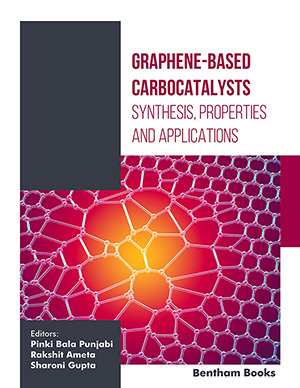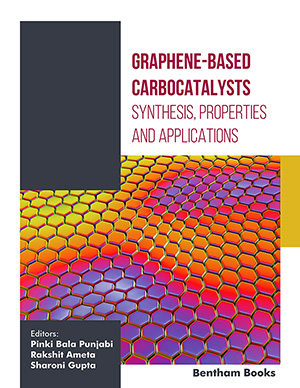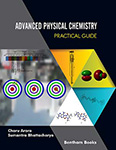Abstract
Background: Oxalate ligand-based metal complexes have long been used for the thermal synthesis of metal oxides. Polymeric homo/heterometallic oxalate-based molecular materials of the general formula, {A]MIIMIII[C2O4]3]}∞, [A = organic cation, MII/MIII: di/trivalent transition metal ion; C2O4: oxalate ligand] provides a molecular source to prepare metal oxides through solid state thermal decomposition primarily due to the potential to tune the materials’ outcome by adjusting the molecular stoichiometry and composition.
Objective: The study aims to explore the effect of mixing at the di- and trivalent metal sites of {N[n-C4H9]4]FeIIFeIII[C2O4]3]}∞ which decomposes to hematite, on the nature of thermal decomposition reaction as well as the nature of the obtained decomposed materials.
Methods: Two series of materials {N[n-C4H9]4]FeII1-xZnII xFeIII[C2O4]3]}∞ and {N[n- C4H9]4]FeIIFeIII1-xCrIIIx[C2O4]3]}∞ were prepared as precursors for non-isothermal thermogravimetry [TG] study. Model-free integral isoconversional method is employed to calculate the activation energy of decomposition, and hence the most probable reaction mechanism, as well as the reaction rate of thermal decomposition, was determined. Based on the kinetic parameters, the important thermodynamic parameters such as the changes of entropy, enthalpy, and Gibbs free energy are estimated for the activated complex formation from the precursors. Powder X-ray diffraction studies were made to identify the decomposed materials.
Results: For materials with 0 < x ≤ 1 well-defined two-step and one-step decomposition process were observed for {N[n-C4H9]4]FeII1-xZnII xFeIII[C2O4]3]}∞ and {N[n- C4H9]4]FeIIFeIII1-xCrIIIx[C2O4]3]}∞, respectively. For each series of materials, a systematic dependence of the activation energy on the extent of conversion indicates a systematic change in the reactivity. The thermal decomposition strongly depends on the extent of mixing at the di- and trivalent sites and proceeds through different reaction mechanisms at different rates. On the decomposition of these series of materials, a range of metal oxides was obtained. Possibly, during such extent of mixing dependent reactions, the reactant particles go through modifications in their reactivity by several factors.
Conclusion: Present work may invoke interest in solid state synthesis of different metal oxides under controlled thermal decomposition by identifying the rate controlling the process through reaction kinetics study for better synthesis and manoeuvring.
Keywords: Thermal decomposition, oxalate-based molecular materials, thermogravimetry, kinetic calculations, iso-conversional method, XRD.
[http://dx.doi.org/10.1016/j.jallcom.2009.03.027]
[http://dx.doi.org/10.1166/jnn.2009.206] [PMID: 19452962]
[http://dx.doi.org/10.1166/jnn.2009.1133] [PMID: 19928271]
[http://dx.doi.org/10.1515/amm-2016-0289]
[http://dx.doi.org/10.1016/j.matchemphys.2009.11.040]
[http://dx.doi.org/10.1002/pc.22300]
[http://dx.doi.org/10.1039/B609630A]
[http://dx.doi.org/10.1021/j150571a021]
[http://dx.doi.org/10.1016/0040-6031(87)88127-3]
[http://dx.doi.org/10.1007/BF02549321]
[http://dx.doi.org/10.1016/S0040-6031(01)00535-4]
[http://dx.doi.org/10.1016/S0254-0584(03)00137-8]
[http://dx.doi.org/10.1016/j.jmrt.2021.11.012]
[http://dx.doi.org/10.2174/1877944107666161208120622]
[http://dx.doi.org/10.1016/j.jallcom.2010.05.031]
[http://dx.doi.org/10.1021/ic950703v] [PMID: 11666309]
[http://dx.doi.org/10.1080/10587259308054965]
[http://dx.doi.org/10.1021/ja00044a004]
[http://dx.doi.org/10.1143/JJAP.34.1521]
[http://dx.doi.org/10.1016/0020-1693(93)03711-I]
[http://dx.doi.org/10.1016/0304-8853(95)00485-8]
[http://dx.doi.org/10.1007/s10765-012-1293-y]
[http://dx.doi.org/10.1007/s10765-016-2099-0]
[http://dx.doi.org/10.1016/0921-4526(93)90108-I]
[http://dx.doi.org/10.1016/j.tca.2011.03.034]
[http://dx.doi.org/10.1002/kin.21077]
[http://dx.doi.org/10.2174/1877946809666190201131731]
[http://dx.doi.org/10.2174/1877946809666190201142153]
[http://dx.doi.org/10.1002/kin.21155]
[http://dx.doi.org/10.1002/1096-987X(20010130)22:2<178:AID-JCC5>3.0.CO;2-#]
[http://dx.doi.org/10.1002/aic.10732]
[http://dx.doi.org/10.1016/j.jaap.2007.12.003]
[http://dx.doi.org/10.1016/0040-6031(92)85118-F]
[http://dx.doi.org/10.2298/JSC120519145B]
[http://dx.doi.org/10.1021/j150553a045]
[http://dx.doi.org/10.1039/jr9630002617]
[http://dx.doi.org/10.1016/0040-6031(82)85076-4]



















